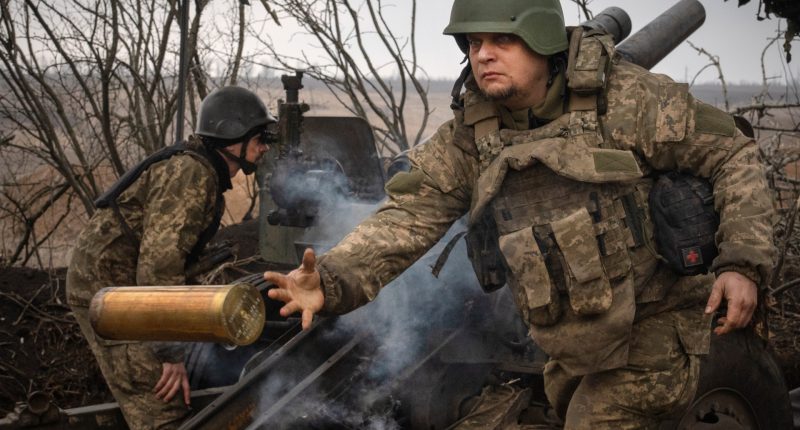Ukraine has repelled a battalion-sized mechanised assault on its eastern front – the first attack of such a scale in five months – proving the resilience of its defences, but raising concerns that Russia is becoming increasingly ambitious as it gears up for an expected major offensive.
The attack on Sunday reportedly included three dozen tanks and a dozen infantry fighting vehicles, and struck near Tonenke, a village close to Avdiivka, the city Russia overran on February 17 and has been inching westward from ever since. A Ukrainian serviceman reported that a third of the tanks and two-thirds of the infantry fighting vehicles were destroyed.
“The start was very good. We carried out combined fire,” said a Russian trainer of Storm-Z assault forces. “On subsequent approaches, which lasted until lunchtime, the fire supply dwindled to sparse artillery fire … and then significant losses began.”
Yet he noted that the last group of vehicles to enter the fray suffered no losses, possibly indicating that local Ukrainian defences had been exhausted: “I would venture to cautiously suggest that these regular visits could ultimately overload the enemy’s strike capabilities.”
“We are trying to find some way not to retreat,” Ukrainian President Volodymyr Zelenskyy told the Washington Post’s David Ignatius in an interview published two days before the battle.
“If there is no US support, it means that we have no air defence, no Patriot missiles, no jammers for electronic warfare, no 155-millimetre artillery rounds,” he said. “It means we will go back, retreat, step by step, in small steps.”
Some $60.1bn in United States military aid the administration of Joe Biden requested last December has been stalled by a small group of lawmakers loyal to former President Donald Trump, who hopes to return to power in the November election.
Europe was stepping in to cover some of the shortages. A Czech initiative had reportedly located a million artillery shells around the world which would start to be delivered to Ukraine this month; and France pledged hundreds of reconditioned armoured personnel vehicles.
Ukrainian commander-in-chief Oleksandr Syrskii told Ukrinform that Avdiivka would not have fallen if deliveries of Western military aid had been more constant, and that the Ukrainian counteroffensive that reclaimed much of Kharkiv and Kherson in September 2022 would have been more sustained.
He said Ukrainian soldiers were outnumbered, and outgunned by a ratio of 6:1, but despite this Russians were suffering staggering losses – 570 tanks, 1,430 armoured vehicles and 1,680 artillery systems in the last two months alone – thanks to changes in tactics that optimised available resources.
Russia creeps forward
Although Ukrainian forces had largely managed to stabilise the front line following the fall of Avdiivka, Ukraine was not prepared to stop another major Russian offensive, Zelenskyy told the US broadcaster CBS. “Partners are sometimes really happy that we have stabilised the situation,” Zelenskyy said. “No, I say we need help now.”
And that stabilisation is not 100 percent solid. Russian forces have continued to make marginal advances.
Most of these have been in the neighbourhood of Avdiivka. Despite their defeat on Sunday, they made marginal gains west of Tonenke, and were photographed in the settlements of Semenivka and Berdychi, both northwest of Avdiivka, on Monday and Tuesday.
To the south, they advanced into the settlement of Novomykhailivka, southwest of Donetsk city, on March 27. And at the northern end of the front, in Luhansk, they began to creep into Bilohorivka on Tuesday.
Russian defence minister Sergei Shoigu boasted in a Tuesday conference call with military personnel that Russian forces had gained 403sq km since the beginning of the year. The Institute for the Study of War, a Washington-based think tank, put the figure at 305sq km since January 1, and a total of 505sq km – five times the size of Paris – since Russian forces went on the offensive in October.
Russia trying to power down Ukraine’s industry
Russia has been targeting Ukraine’s power plants, and in the past week began to bomb hydroelectric power stations in addition to thermal power plants. The Kaniv Hydroelectric Power Plant, 80km southeast of Kyiv, and the Dnister Hydroelectric Power Plant, 300km southwest of Kyiv, just north of the Moldovan border, have been among the main targets.
The barrage of drones and missiles that targeted these dams and other infrastructure was massive: 60 Iranian-designed Shahed drones and 37 missiles of various types. Ukraine managed to down 58 of the drones and 26 of the missiles, but Zelenskyy stressed the need for greater air defence. “It is necessary to replenish supplies more quickly,” he said. Zelenskyy told the Washington Post that air defence ammunition was running low, and CBS that Ukraine could lock its skies to Russian attacks with another five to seven Patriot batteries.
“The range of possible outcomes from most advantageous to most dangerous – is very wide and will remain so until it is clear whether the US will resume military support,” said the ISW.
The other great variable, it said, was Ukrainian manpower, and on Tuesday Zelenskyy signed into law a long-awaited bill lowering the conscription age from 27 to 25. The bill is expected to raise up to half a million new soldiers for Ukraine, though Syrskii said a more efficient rotation of existing manpower had made that scale of recruitment unnecessary.
Russia also reached a new milestone on March 22, when it completely destroyed one of the largest thermal power plants in Kharkiv. “All units were destroyed” at the Zmiivska power plant said its operator, Tsentrenergo. “The degree of destruction is different.”
Ukrainian foreign minister Dmytro Kuleba said Russia had launched 140 drones and 190 missiles against civilian infrastructure far from the front lines in just one week, from March 18 to 24. French defence minister Sebastien Lecornu said his country would provide Aster 30 surface-to-air missiles to strengthen air defence.
Ukraine fights back
Ukraine’s response has been to target Russian energy infrastructure back – specifically oil refineries – and on Tuesday a Ukrainian drone struck the Taneko refinery in Tatarstan, Russia’s third largest refining facility, more than 1,000km (600 miles) from the Ukrainian border. Tatarstan head Rustam Minnikhanov claimed “no serious damage” was done, but Reuters reported that the drone had struck a core refining unit and reduced the plant’s capacity by half.
In the same strike, Ukraine also hit a dormitory at the Alabuga Polytechnic, which is reportedly used to build Shahed drones. Ukrainian military intelligence (GUR), which conducted the strike, said there was “significant destruction of production facilities”.
GUR deputy head Vadym Skibitskyi predicted that Russia would pause its missile strikes against Ukraine after two or three more waves of strikes in order to replenish stocks.
“Russia has about 950 high-precision missiles of the operational-strategic and strategic level with a range of more than 350 kilometres. We observe a tendency that they, as a rule, try to keep their stocks at the level of at least 900 missiles,” Skibitskyi said.
Also Read More: World News | Entertainment News | Celebrity News







